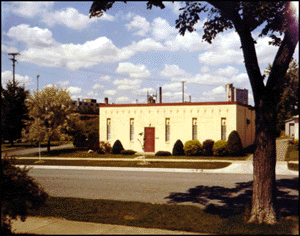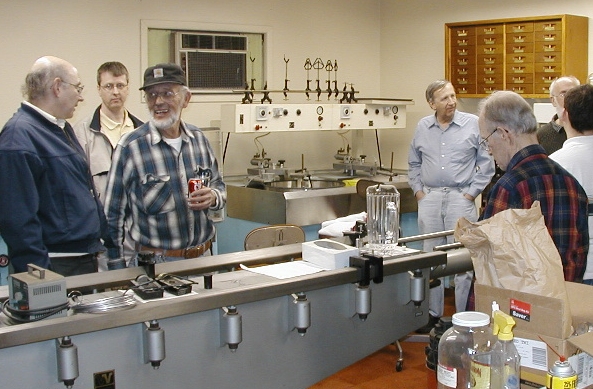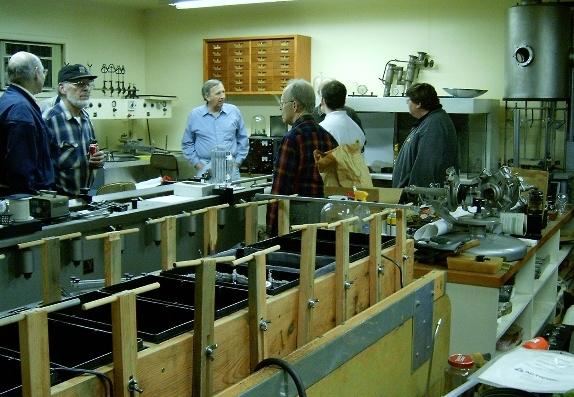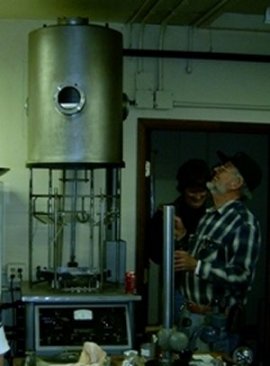The Facility

You are invited to look at Bill Volna's Retirement Sandbox. Having recently reached the age of eighty-six, Bill, a mechanical engineer, has put together this addition to his website for your enjoyment. The Sandbox is a small block building that Bill built with the help of his dad, Max, and nephew, Steven, in 1968. It became the home of Volna Engineering Company.
Bill, now retired, goes almost every day to his "Sandbox" — sometimes called the Volna Engineering Tech School — and enjoys life with his numerous interests, including mentoring younger enthusiasts with their hobbies. He shares a lifetime of engineering experiences with friends, including analysis, in jest, of many things that were failures, as well as some that succeeded.
Space at the Sandbox is available on demand to members of the Special Interest Group (SIG) of the Minnesota Astronomical Society (MAS) as a place to hold meetings and bring projects made by members for "show and tell." At one of the first SIG meetings, held on 6 April 2006, member Carl Anderson took pictures of Bill doing a walking tour of the facility. That gathering serves as an opening benchmark for the Sandbox pictures, followed by others with captions that describe Bill's lifetime as a "builder/doer." Enjoy!

Fig. 1 Bill at the blackboard, sharing instrument design concepts that involve principles of exact constraint. He muses an interesting comment from the great Clerk Maxwell, "If a body has more than six degrees of constraint, a condition of stress occurs," a very important insight in instrument design from an unlikely author.

Fig. 2 This cabinet is filled with a lifetime of Bill's gadgets that he uses to teach design principles. It contains some of his old ham gear and other electrical gizmos.

Fig. 3 In 1960, Bill made this astronomical clock from plans published in Amateur Telescope Making, Book 2, by Ben L. Souther. Its design by W.H. Shortt is a two-pendulum system that held sway as the most accurate clock in the world until the advent of the quartz-crystal clock. The Sychronome Co. built sixty of them, found in observatories around the world. Ben bought castings for his clock from the Synchronome Co. in England. An added refinement in Bill's clock are sapphire-jeweled bearings, commonly used in mechanical gyroscopes.

Fig. 4 On Bill's desk at the Sandbox is Amateur Telescope Making, Book 2. The left-hand page shows Ben Souther and his wife. On the right is Ben's "original astronomical precision clock," which was patterned after those used at the Prime Meridian in Greenwich, England. In 1972, Bill had a chance to meet Ben, who came through town on his way to a high school reunion in Redwing, MN. During that visit, Bill told Ben that he would like to put Ben's clock on the wall next to his own. Soon after that visit, Bill became the owner of Ben's clock.

Fig. 5 Bill demonstrates his patented device, known as "Square Head", for squaring spindles on a Bridgeport milling machine, making it easy to line up the milling head perpendicular to the table.

Fig. 6 Behind the shop, in a separate building, is Bill's optics lab. Here the group stands around a ten-foot optical bench that Bill designed and built 35 years earlier for a Honeywell project and later bought back when they no longer needed it.

Fig. 7 Bill is currently grinding an 8-in. achromatic doublet for his new telescope, "Tardis II." Here he shows a fixture made for measuring lens edge thickness. Maintaining a constant edge thickness is important for good image quality in the finished lens. Maintaining a tolerance of .001 in. is easy.

Fig. 8 Bill assembled this row of chemical tanks for anodizing small aluiminum parts with many colors.

Fig. 9 This vacuum coater was purchased from the estate of E & W Optical Co., where it was used for many years. Its maximum capacity is 16 inches.

Fig. 10 These two large vacuum coaters were used at Sperry for the NIKI missile program. They produced a type of non-volatile magnetic memory called "mated thin film core array." With these vacuum chambers, Bill can aluminize mirrors up to 35 inches in diameter.

Fig. 11 A close-up view of the vacuum coater in Fig. 9.

Fig. 12 A close-up view of the two large vacuum coaters in Fig. 10. On the right is a filament array used in the two chambers.

Fig. 13 A row of Strasbaugh polishing machines.